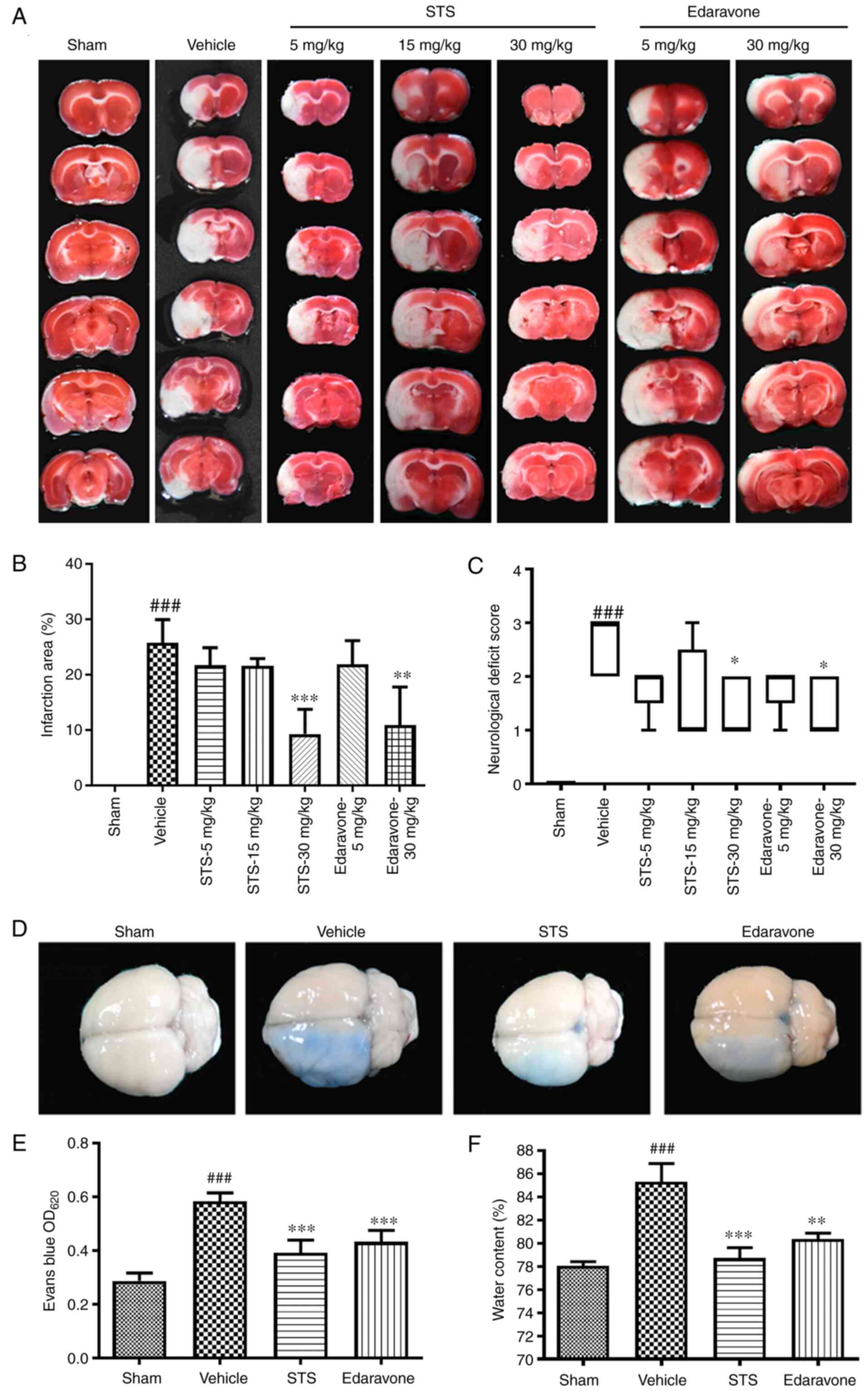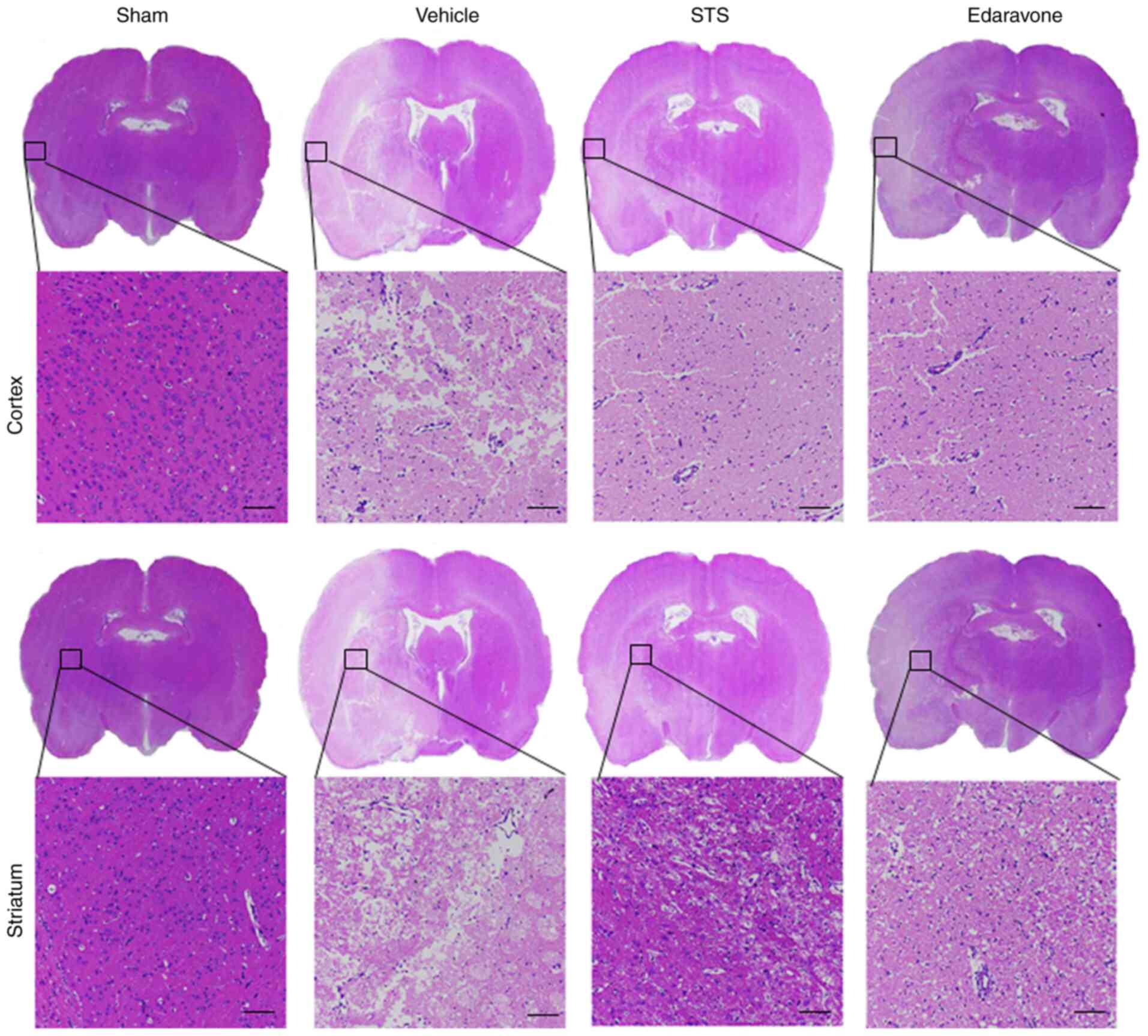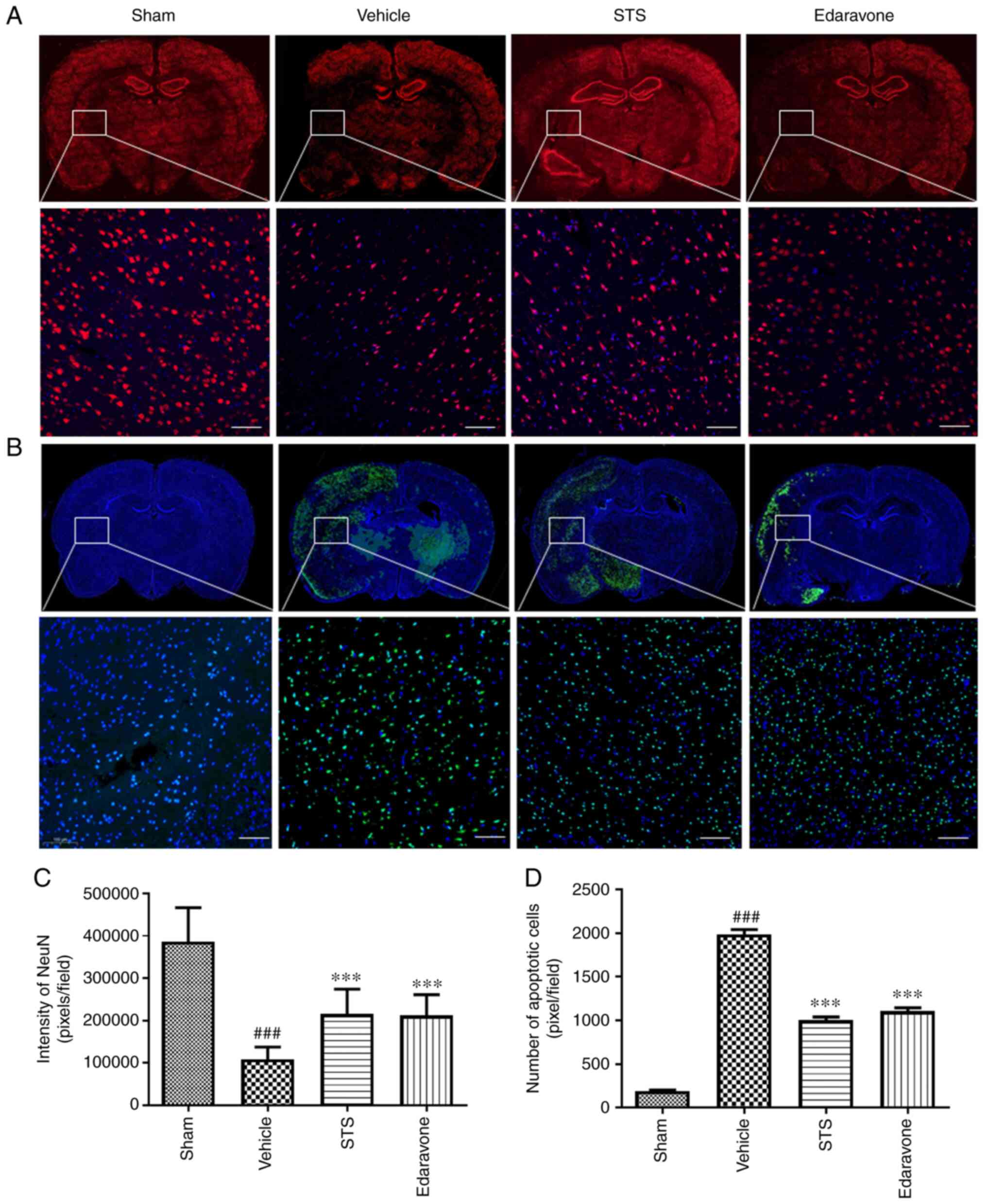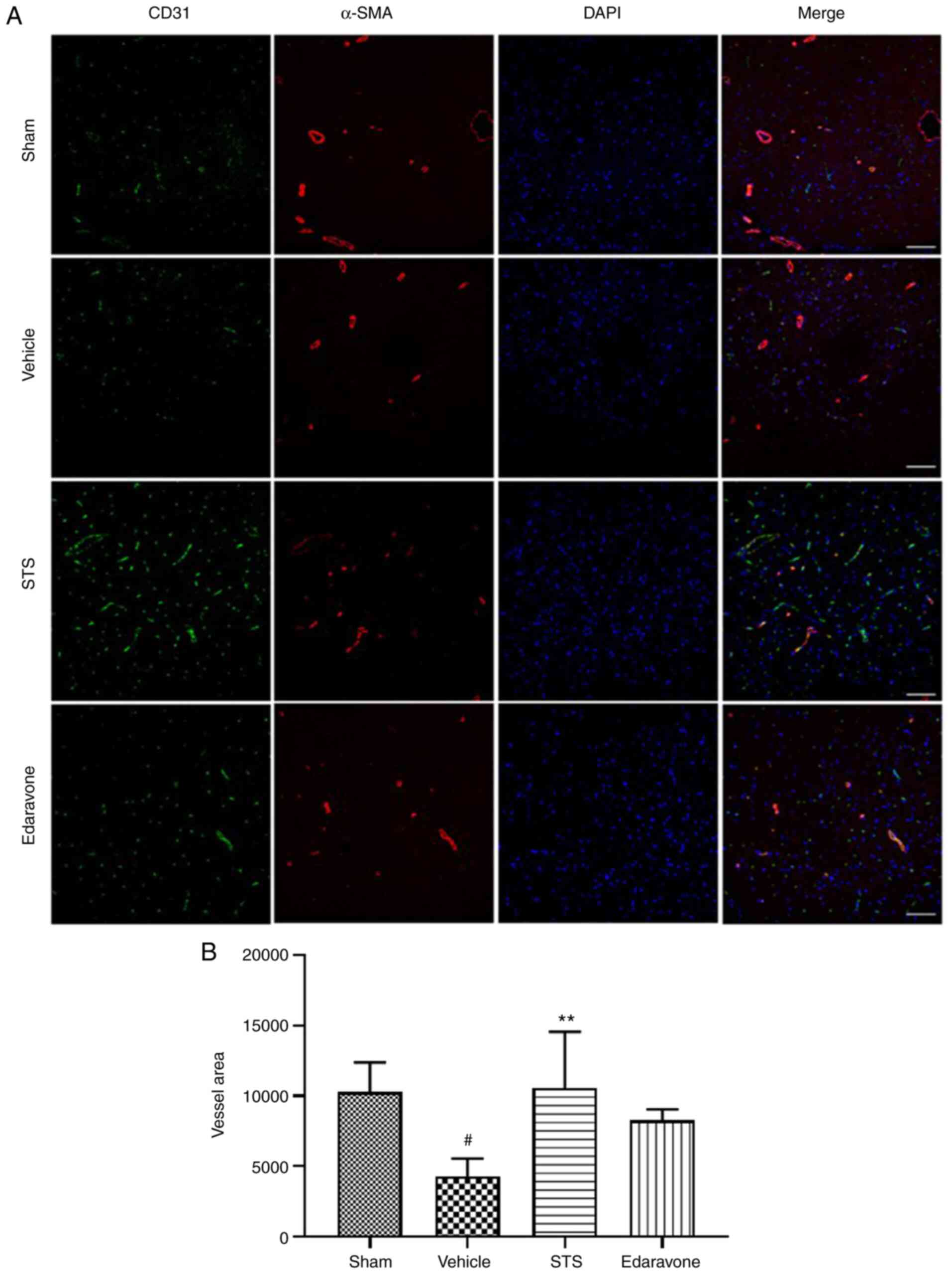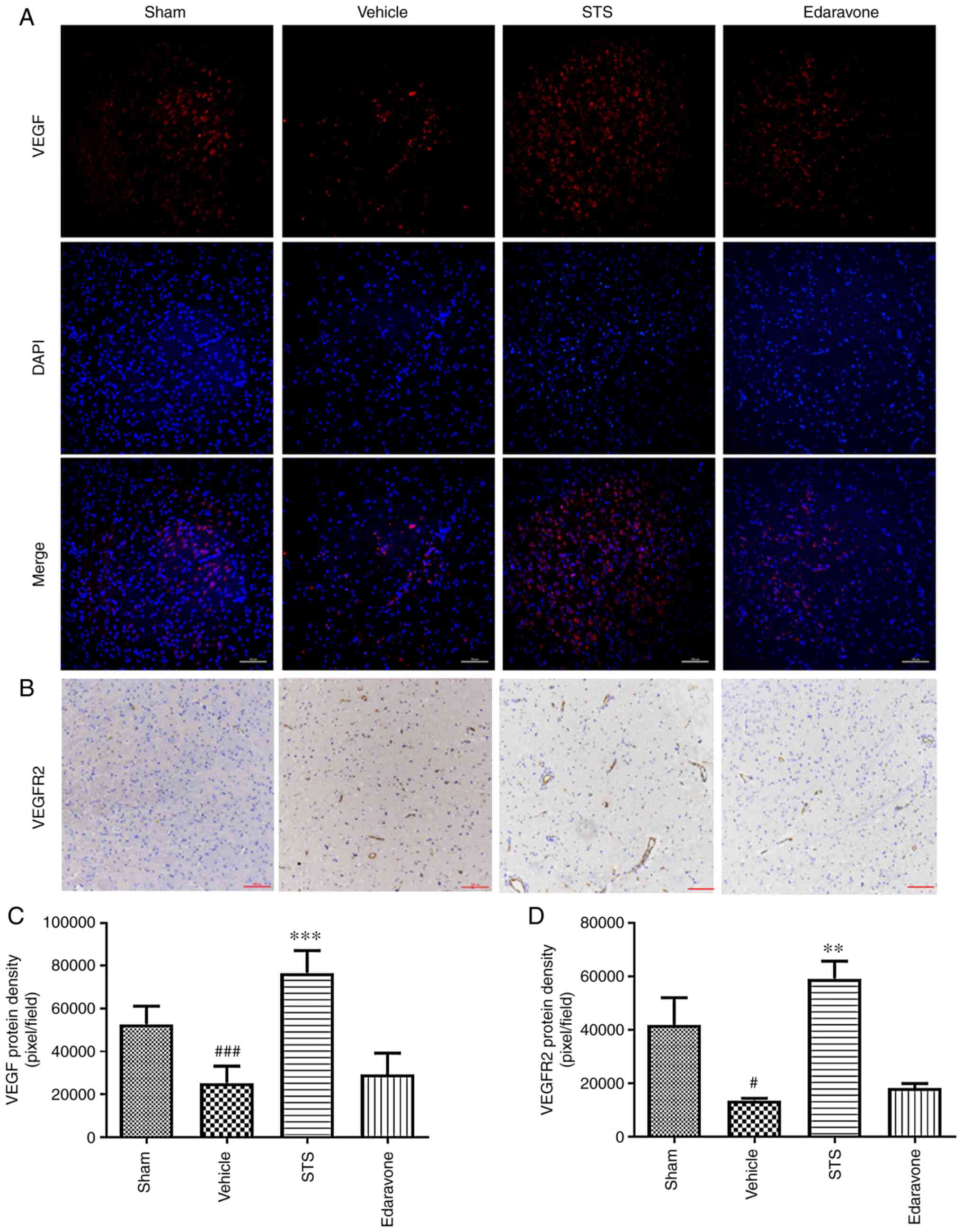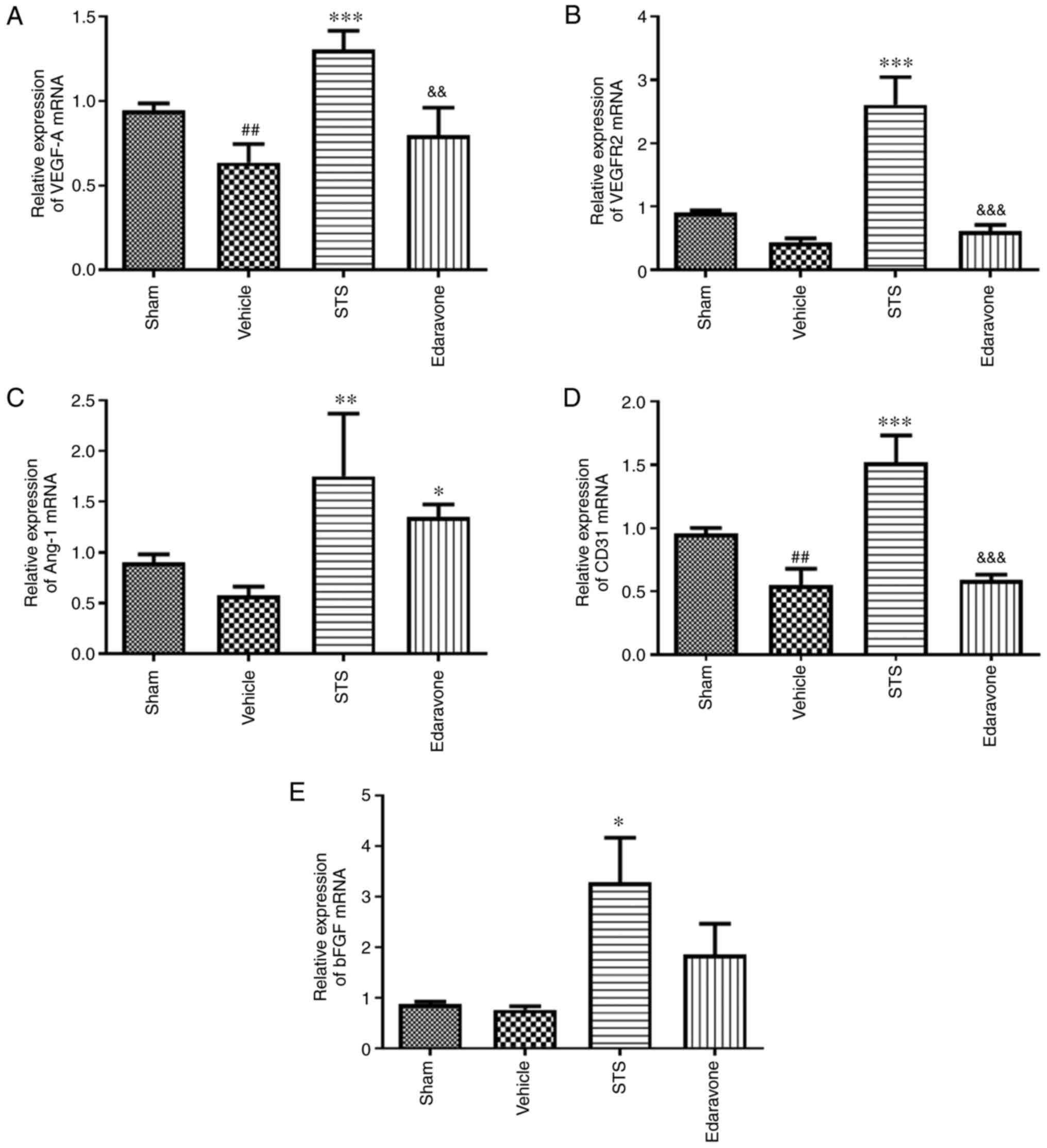|
1
|
Benjamin EJ, Blaha MJ, Chiuve SE, Cushman
M, Das SR, Deo R, De Ferranti SD, Floyd JS, Fornage M, Gillespie C,
et al: Heart disease and stroke statistics-2017 update: A report
from the American heart association. Circulation. 135:e146–e603.
2017.PubMed/NCBI View Article : Google Scholar
|
|
2
|
Benjamin EJ, Virani SS, Callaway CW,
Chamberlain AM, Chang AR, Cheng S, Chiuve SE, Cushman M, Delling
FN, Deo R, et al: Heart disease and stroke statistics-2018 update:
A report from the American heart association. Circulation.
137:e67–e492. 2018.PubMed/NCBI View Article : Google Scholar
|
|
3
|
Winstein CJ, Stein J, Arena R, Bates BE,
Cherney LR, Cramer SC, Deruyter F, Eng JJ, Fisher BE, Harvey RL, et
al: Guidelines for adult stroke rehabilitation and recovery: A
guideline for healthcare professionals from the American heart
association/American stroke association. Stroke. 47:e98–e169.
2016.PubMed/NCBI View Article : Google Scholar
|
|
4
|
Shang Q, Xu H and Huang L: Tanshinone IIA:
A promising natural cardioprotective agent. Evid Based Complement
Alternat Med. 2012(716459)2012.PubMed/NCBI View Article : Google Scholar
|
|
5
|
Shang QH, Wang H, Li SM and Xu H: The
effect of sodium tanshinone IIA sulfate and simvastatin on elevated
serum levels of inflammatory markers in patients with coronary
heart disease: A study protocol for a randomized controlled trial.
Evid Based Complement Alternat Med. 2013(756519)2013.PubMed/NCBI View Article : Google Scholar
|
|
6
|
Tang J, Zhu C, Li ZH, Liu XY, Sun SK,
Zhang T, Luo ZJ, Zhang H and Li WY: Inhibition of the spinal
astrocytic JNK/MCP-1 pathway activation correlates with the
analgesic effects of tanshinone IIA sulfonate in neuropathic pain.
J Neuroinflamm. 12(57)2015.PubMed/NCBI View Article : Google Scholar
|
|
7
|
Zhang H, Long M, Wu Z, Han X and Yu Y:
Sodium tanshinone IIA silate as an add-on therapy in patients with
unstable angina pectoris. J Thorac Dis. 6:1794–1799.
2014.PubMed/NCBI View Article : Google Scholar
|
|
8
|
Zhao YP, Wang F, Jiang W, Liu J, Liu BL,
Qi L and Zhou W: A mitochondrion-targeting tanshinone IIA
derivative attenuates myocardial hypoxia reoxygenation injury
through a SDH-dependent antioxidant mechanism. J Drug Target.
27:896–902. 2019.PubMed/NCBI View Article : Google Scholar
|
|
9
|
Hu Q, Wei B, Wei L, Hua K, Yu X, Li H and
Ji H: Sodium tanshinone IIA sulfonate ameliorates ischemia-induced
myocardial inflammation and lipid accumulation in beagle dogs
through NLRP3 inflammasome. Int J Cardiol. 196:183–192.
2015.PubMed/NCBI View Article : Google Scholar
|
|
10
|
Xu W, Yang J and Wu LM: Cardioprotective
effects of tanshinone IIA on myocardial ischemia injury in rats.
Pharmazie. 64:332–336. 2009.PubMed/NCBI
|
|
11
|
Morton JS, Andersson IJ, Cheung P, Baker
PN and Davidge ST: The vascular effects of sodium tanshinone IIA
sulphonate in rodent and human pregnancy. PLoS One.
10(e0121897)2015.PubMed/NCBI View Article : Google Scholar
|
|
12
|
Ji B, Zhou F, Han L, Yang J, Fan H, Li S,
Li J, Zhang X, Wang X and Chen X: Sodium tanshinone IIA sulfonate
enhances effectiveness Rt-PA treatment in acute ischemic stroke
patients associated with ameliorating blood-brain barrier damage.
Transl Stroke Res. 8:334–340. 2017.PubMed/NCBI View Article : Google Scholar
|
|
13
|
Zhou ZY, Huang B, Li S, Huang XH, Tang JY,
Kwan YW, Hoi PM and Lee SMY: Sodium tanshinone IIA sulfonate
promotes endothelial integrity via regulating VE-cadherin dynamics
and RhoA/ROCK-mediated cellular contractility and prevents
atorvastatin-induced intracerebral hemorrhage in zebrafish. Toxicol
Appl Pharmacol. 350:32–42. 2018.PubMed/NCBI View Article : Google Scholar
|
|
14
|
Li Z, Zhang S, Cao L, Li W, Ye YC, Shi ZX,
Wang ZR, Sun LX, Wang JW, Jia LT and Wang W: Tanshinone IIA and
Astragaloside IV promote the angiogenesis of mesenchymal stem
cell-derived endothelial cell-like cells via upregulation of Cx37,
Cx40 and Cx43. Exp Ther Med. 16:1847–1854. 2018.PubMed/NCBI View Article : Google Scholar
|
|
15
|
Garcia JH, Wagner S, Liu KF and Hu XJ:
Neurological deficit and extent of neuronal necrosis attributable
to middle cerebral artery occlusion in rats. Statistical
validation. Stroke. 26:627–635. 1995.PubMed/NCBI View Article : Google Scholar
|
|
16
|
Lo EH: A new penumbra: Transitioning from
injury into repair after stroke. Nat Med. 14:497–500.
2008.PubMed/NCBI View
Article : Google Scholar
|
|
17
|
Ma F, Morancho A, Montaner J and Rosell A:
Endothelial progenitor cells and revascularization following
stroke. Brain Res. 1623:150–159. 2015.PubMed/NCBI View Article : Google Scholar
|
|
18
|
Jiang Y, Li L, Ma J, Zhang L, Niu F, Feng
T and Li C: Auricular vagus nerve stimulation promotes functional
recovery and enhances the post-ischemic angiogenic response in an
ischemia/reperfusion rat model. Neurochem Int. 97:73–82.
2016.PubMed/NCBI View Article : Google Scholar
|
|
19
|
Han L and Li J, Chen Y, Zhang M, Qian L,
Chen Y, Wu Z, Xu Y and Li J: Human urinary kallidinogenase promotes
angiogenesis and cerebral perfusion in experimental stroke. PLoS
One. 10(e0134543)2015.PubMed/NCBI View Article : Google Scholar
|
|
20
|
Hui Z, Sha DJ, Wang SL, Li CS, Qian J,
Wang JQ, Zhao Y, Zhang JH, Cheng HY, Yang H, et al: Panaxatriol
saponins promotes angiogenesis and enhances cerebral perfusion
after ischemic stroke in rats. BMC Complement Altern Med.
17(70)2017.PubMed/NCBI View Article : Google Scholar
|
|
21
|
Petcu EB, Smith RA, Miroiu RI and Opris
MM: Angiogenesis in old-aged subjects after ischemic stroke: A
cautionary note for investigators. J Angiogenes Res.
2(26)2010.PubMed/NCBI View Article : Google Scholar
|
|
22
|
Arai K, Jin G, Navaratna D and Lo EH:
Brain angiogenesis in developmental and pathological processes:
Neurovascular injury and angiogenic recovery after stroke. FEBS J.
276:4644–4652. 2009.PubMed/NCBI View Article : Google Scholar
|
|
23
|
Li W, Fraser JL, Yu SP, Zhu J, Jiang Y and
Wei L: The role of VEGF/VEGFR2 signaling in peripheral
stimulation-induced cerebral neurovascular regeneration after
ischemic stroke in mice. Exp Brain Res. 214:503–513.
2011.PubMed/NCBI View Article : Google Scholar
|
|
24
|
Lee DH, Lee J, Jeon J, Kim KJ, Yun JH,
Jeong HS, Lee EH, Koh YJ and Cho CH: Oleanolic acids inhibit
vascular endothelial growth factor receptor 2 signaling in
endothelial cells: Implication for anti-angiogenic therapy. Mol
Cells. 41:771–780. 2018.PubMed/NCBI View Article : Google Scholar
|
|
25
|
Wise GE and Yao S: Expression of vascular
endothelial growth factor in the dental follicle. Crit Rev Eukaryot
Gene Expr. 13:173–180. 2003.PubMed/NCBI
|
|
26
|
Krum JM, Mani N and Rosenstein JM:
Angiogenic and astroglial responses to vascular endothelial growth
factor administration in adult rat brain. Neuroscience.
110:589–604. 2002.PubMed/NCBI View Article : Google Scholar
|
|
27
|
Melincovici CS, Boşca AB, Şuşman S,
Mărginean M, Mihu C, Istrate M, Moldovan IM, Roman AL and Mihu CM:
Vascular endothelial growth factor (VEGF)-key factor in normal and
pathological angiogenesis. Rom J Morphol Embryol. 59:455–467.
2018.PubMed/NCBI
|
|
28
|
Wang Y, Jin K, Mao XO, Xie L, Banwait S,
Marti HH and Greenberg DA: VEGF-overexpressing transgenic mice show
enhanced post-ischemic neurogenesis and neuromigration. J Neurosci
Res. 85:740–747. 2007.PubMed/NCBI View Article : Google Scholar
|
|
29
|
Asahara T, Chen D, Takahashi T, Fujikawa
K, Kearney M, Magner M, Yancopoulos GD and Isner JM: Tie2 receptor
ligands, angiopoietin-1 and angiopoietin-2, modulate VEGF-induced
postnatal neovascularization. Circ Res. 83:233–240. 1998.PubMed/NCBI View Article : Google Scholar
|
|
30
|
Wang L, Xiong X, Zhang X, Ye Y, Jian Z,
Gao W and Gu L: Sodium tanshinone IIA sulfonate protects against
cerebral ischemia-reperfusion injury by inhibiting autophagy and
inflammation. Neuroscience. 441:46–57. 2020.PubMed/NCBI View Article : Google Scholar
|
|
31
|
Chen L, He W, Peng B, Yuan M, Wang N, Wang
J, Lu W and Wang T: Sodium tanshinone IIA sulfonate improves
post-ischemic angiogenesis in hyperglycemia. Biochem Biophys Res
Commun. 520:580–585. 2019.PubMed/NCBI View Article : Google Scholar
|
|
32
|
Zhou Z, Wei X, Xiang J, Gao J, Wang L, You
J, Cai Y and Cai D: Protection of erythropoietin against ischemic
neurovascular unit injuries through the effects of connexin43.
Biochem Biophys Res Commun. 458:656–662. 2015.PubMed/NCBI View Article : Google Scholar
|
|
33
|
Longa EZ, Weinstein P, Carlson S and
Cummins R: Reversible middle cerebral artery occlusion without
craniectomy in rats. Stroke. 20:84–91. 1989.PubMed/NCBI View Article : Google Scholar
|
|
34
|
Wang J, Zhang D, Fu X, Yu L, Lu Z, Gao Y,
Liu X, Man J, Li S, Li N, et al: Carbon monoxide-releasing
molecule-3 protects against ischemic stroke by suppressing
neuroinflammation and alleviating blood-brain barrier disruption. J
Neuroinflammation. 15(188)2018.PubMed/NCBI View Article : Google Scholar
|
|
35
|
Li D, Lang W, Zhou C, Wu C, Zhang F, Liu
Q, Yang S and Hao J: Upregulation of microglial ZEB1 ameliorates
brain damage after acute ischemic stroke. Cell Rep. 22:3574–3586.
2018.PubMed/NCBI View Article : Google Scholar
|
|
36
|
Gilmer LK, Roberts KN and Scheff SW:
Efficacy of progesterone following a moderate unilateral cortical
contusion injury. J Neurotrauma. 25:593–602. 2008.PubMed/NCBI View Article : Google Scholar
|
|
37
|
Luan P, Xu J, Ding X, Cui Q, Jiang L, Xu
Y, Zhu Y, Li R, Lin G, Tian P and Zhang J: Neuroprotective effect
of salvianolate on cerebral ischaemia-reperfusion injury in rats by
inhibiting the caspase-3 signal pathway. Eur J Pharmacol.
872(172944)2020.PubMed/NCBI View Article : Google Scholar
|
|
38
|
Zhu Y, Yang L, Xu J, Yang X, Luan P, Cui
Q, Zhang P, Wang F, Li R, Ding X, et al: Discovery of the
anti-angiogenesis effect of eltrombopag in breast cancer through
targeting of HuR protein. Acta Pharm Sin B. 10:1414–1425.
2020.PubMed/NCBI View Article : Google Scholar
|
|
39
|
Taguchi A, Soma T, Tanaka H, Kanda T,
Nishimura H, Yoshikawa H, Tsukamoto Y, Iso H, Fujimori Y, Stern DM,
et al: Administration of CD34+ cells after stroke
enhances neurogenesis via angiogenesis in a mouse model. J Clin
Invest. 114:330–338. 2004.PubMed/NCBI View Article : Google Scholar
|
|
40
|
Zhang ZG, Zhang L, Jiang Q, Zhang RL,
Davies K, Powers C, Bruggen NV and Chopp M: VEGF enhances
angiogenesis and promotes blood-brain barrier leakage in the
ischemic brain. J Clin Invest. 106:829–838. 2000.PubMed/NCBI View Article : Google Scholar
|
|
41
|
Zhou L, Zuo Z and Chow MS: Danshen: An
overview of its chemistry, pharmacology, pharmacokinetics, and
clinical use. J Clin Pharmacol. 45:1345–1359. 2005.PubMed/NCBI View Article : Google Scholar
|
|
42
|
Chan P, Liu IM, Li YX, Yu WJ and Cheng JT:
Antihypertension induced by tanshinone IIA isolated from the roots
of Salvia miltiorrhiza. Evid Based Complement Alternat Med.
2011(392627)2011.PubMed/NCBI View Article : Google Scholar
|
|
43
|
Gong P, Zhang Z, Zou C, Tian Q, Chen X,
Hong M, Liu X, Chen Q, Xu Z, Li M and Wang J: Hippo/YAP signaling
pathway mitigates blood-brain barrier disruption after cerebral
ischemia/reperfusion injury. Behav Brain Res. 356:8–17.
2019.PubMed/NCBI View Article : Google Scholar
|
|
44
|
Giraud M, Cho TH, Nighoghossian N,
Maucort-Boulch D, Deiana G, Østergaard L, Baron JC, Fiehler J,
Pedraza S, Derex L and Berthezène Y: Early blood brain barrier
changes in acute ischemic stroke: A sequential MRI study. J
Neuroimaging. 25:959–963. 2015.PubMed/NCBI View Article : Google Scholar
|
|
45
|
Navaratna D, Guo S, Arai K and Lo EH:
Mechanisms and targets for angiogenic therapy after stroke. Cell
Adh Migr. 3:216–223. 2009.PubMed/NCBI View Article : Google Scholar
|
|
46
|
Ampofo E, Schmitt BM, Menger MD and
Laschke MW: Targeting the microcirculation by indole-3-carbinol and
its main derivate 3,3,'-diindolylmethane: Effects on angiogenesis,
thrombosis and inflammation. Mini Rev Med Chem. 18:962–968.
2018.PubMed/NCBI View Article : Google Scholar
|
|
47
|
Zhu W, Lv Q, Chen H, Wang Z and Zhong Q:
Protective effect and mechanism of sodium tanshinone II A sulfonate
on microcirculatory disturbance of small intestine in rats with
sepsis. J Huazhong Univ Sci Technolog Med Sci.
31(441)2011.PubMed/NCBI View Article : Google Scholar
|
|
48
|
Sun Y, Jin K, Xie L, Childs J, Mao XO,
Logvinova A and Greenberg DA: VEGF-induced neuroprotection,
neurogenesis, and angiogenesis after focal cerebral ischemia. J
Clin Invest. 111:1843–1851. 2003.PubMed/NCBI View Article : Google Scholar
|
|
49
|
Liu J, Wang Y, Akamatsu Y, Lee CC, Stetler
RA, Lawton MT and Yang GY: Vascular remodeling after ischemic
stroke: Mechanisms and therapeutic potentials. Prog Neurobiol.
115:138–156. 2014.PubMed/NCBI View Article : Google Scholar
|
|
50
|
Pedragosa J, Salas-Perdomo A, Gallizioli
M, Cugota R, Miró-Mur F, Briansó F, Justicia C, Pérez-Asensio F,
Marquez-Kisinousky L, Urra X, et al: CNS-border associated
macrophages respond to acute ischemic stroke attracting
granulocytes and promoting vascular leakage. Acta Neuropathol
Commun. 6(76)2018.PubMed/NCBI View Article : Google Scholar
|















